Multi-Level Fuzzy Comprehensive Evaluation for Water Resources Carrying Capacity in Xuzhou City, China
Abstract
1. Introduction
2. Study Area and Data Sources
2.1. Study Area
2.2. Data Sources
3. Methodology
3.1. Creation of the Evaluation Index System and Grading Standard
3.1.1. Selection of the Evaluation Indexes
3.1.2. Classification of the Evaluation Grades
3.2. Multi-Level Fuzzy Comprehensive Evaluation Model
3.2.1. Model Theory
3.2.2. Calculation of the Membership Degree
3.2.3. Determination of the Evaluation Index Weight
Entropy Method
Analytic Hierarchy Process
- (1)
- Construction of hierarchy: Divide the evaluation indexes of the WRCC in Xuzhou into three layers: the target layer, the criterion layer and the index layer.
- (2)
- Create a judgment matrix R′: Compare factors and determine their relative importance. Calculate the rank of a comparative judgment matrix using the 1–9 scale of importance (Table 2).where Uij is the comparison of the significance of index i and index j.
- (3)
- Calculating the resultant λmax and the corresponding eigenvectors w′. The eigenvectors (weights) w′ were determined:where wi’ is the ith component of w’ obtained from the calculation of R’.Thus, the maximum eigenvalue was determined:where (R’w’)i represents the ith eigenvector component (R’w’).
- (4)
- Due to the complexity of water resources systems and the subjectivity of people’s perceptions, a matrix consistency test was required to eliminate conflicts in the judgments from two comparisons. Consistency was tested using the following formula:where RI is the average value of the random consistency test index; CI is the consistency index, which only passes the consistency test if CR = CI/RI < 0.1; and the value of RI is proportional to the order n of R′ (Table 3).
The Combined Weights
3.2.4. Classification of the Evaluation Grades
3.3. Projection of Approaching and Long-Term Water Resources Carrying Capacity
3.3.1. Projection of Relevant Indexes
Projection of Social and Economic Development-Related Indexes
Projection of Water Supply and Demand-Related Indexes
- (1)
- Annual average precipitation
- (2)
- Total water resources and water production modulus
- (3)
- Total water demand
3.3.2. Scenario Design
4. Results and Discussion
4.1. Analysis of the WRCC Status Evaluation Results
4.1.1. Results of Membership Degree
4.1.2. Results of the WRCC Evaluation Index Weight
4.1.3. Analysis of the WRCC Status Evaluation
4.2. Analysis of WRCC Predictions under Different Scenarios
4.2.1. Scenario A: Sustainable Development
4.2.2. Scenario B: Water Conservation
4.2.3. Scenario C: Rapid Socioeconomic Development
4.2.4. Scenario D: Adjustment of Industrial Structure
4.2.5. Prediction Analysis under Three Water Regimes
5. Conclusions
Supplementary Materials
Author Contributions
Funding
Data Availability Statement
Acknowledgments
Conflicts of Interest
References
- Zhang, H.; Jin, G.; Yu, Y. Review of River Basin Water Resource Management in China. Water 2018, 10, 425. [Google Scholar] [CrossRef]
- Bazrkar, M.H.; Tavakoli-Nabavi, E.; Zamani, N.; Eslamian, S. System dynamic approach to hydro-politics in Hirmand transboundary river basin from sustainability perspective. Int. J. Hydrol. Sci. Technol. 2013, 3, 378–398. [Google Scholar] [CrossRef]
- Moisello, U.; Todeschini, S.; Vullo, F. The effects of water management on annual maximum floods of Lake Como and River Adda at Lecco (Italy). Civ. Eng. Environ. Syst. 2013, 30, 56–71. [Google Scholar] [CrossRef]
- Kummu, M.; Guillaume, J.H.A.; de Moel, H.; Eisner, S.; Flörke, M.; Porkka, M.; Siebert, S.; Veldkamp, T.I.E.; Ward, P.J. The World’s Road to Water Scarcity: Shortage and Stress in the 20th Century and Pathways towards Sustainability. Sci. Rep. 2016, 6, 38495. [Google Scholar] [CrossRef]
- United Nations Educational, Scientific and Cultural Organization. The United Nations World Water Development Report 2020: Water and Climate Change; United Nations Educational, Scientific and Cultural Organization: Paris, France, 2020; p. 232. [Google Scholar]
- Wada, Y.; van Beek, L.P.H.; Bierkens, M.F.P. Modelling Global Water Stress of the Recent Past: On the Relative Importance of Trends in Water Demand and Climate Variability. Hydrol. Earth Syst. Sci. 2011, 15, 3785–3808. [Google Scholar] [CrossRef]
- He, C.; Liu, Z.; Wu, J.; Pan, X.; Fang, Z.; Li, J.; Bryan, B.A. Future Global Urban Water Scarcity and Potential Solutions. Nat. Commun. 2021, 12, 4667. [Google Scholar] [CrossRef]
- Schilling, J.; Hertig, E.; Tramblay, Y.; Scheffran, J. Climate Change Vulnerability, Water Resources and Social Implications in North Africa. Reg. Environ. Chang. 2020, 20, 15. [Google Scholar] [CrossRef]
- Lee, U.; Xu, H.; Daystar, J.; Elgowainy, A.; Wang, M. AWARE-US: Quantifying Water Stress Impacts of Energy Systems in the United States. Sci. Total Environ. 2019, 648, 1313–1322. [Google Scholar] [CrossRef]
- United Nations, Department of Economic and Social Affairs. The Sustainable Development Goals Report 2022; United Nations, Department of Economic and Social Affairs: New York, NY, USA, 2022. [Google Scholar]
- Zhao, H.; Miller, T.R.; Ishii, N.; Kawasaki, A. Global Spatio-Temporal Change Assessment in Interregional Water Stress Footprint in China by a High Resolution MRIO Model. Sci. Total Environ. 2022, 841, 156682. [Google Scholar] [CrossRef]
- Wu, Y.; Ma, Z.; Li, X.; Sun, L.; Sun, S.; Jia, R. Assessment of Water Resources Carrying Capacity Based on Fuzzy Comprehensive Evaluation—Case Study of Jinan, China. Water Supply 2021, 21, 513–524. [Google Scholar] [CrossRef]
- Wu, F.; Zhuang, Z.; Liu, H.-L.; Shiau, Y.-C. Evaluation of Water Resources Carrying Capacity Using Principal Component Analysis: An Empirical Study in Huai’an, Jiangsu, China. Water 2021, 13, 2587. [Google Scholar] [CrossRef]
- Ross, E.A. Introduction to the Science of Society (Robert, E. Park, Ernest, W. Burgess). Am. J. Sociol. 1921, 27, 393–394. [Google Scholar] [CrossRef]
- Hixon, M.A. Carrying Capacity. In Encyclopedia of Ecology; Elsevier: Amsterdam, The Netherlands, 2008; pp. 528–530. [Google Scholar]
- Lane, M.; Dawes, L.; Grace, P. The Essential Parameters of a Resource-Based Carrying Capacity Assessment Model: An Australian Case Study. Ecol. Model. 2014, 272, 220–231. [Google Scholar] [CrossRef]
- Lane, M. The Carrying Capacity Imperative: Assessing Regional Carrying Capacity Methodologies for Sustainable Land-Use Planning. Land Use Policy 2010, 27, 1038–1045. [Google Scholar] [CrossRef]
- Peters, C.J.; Bills, N.L.; Wilkins, J.L.; Fick, G.W. Foodshed Analysis and Its Relevance to Sustainability. Renew. Agric. Food Syst. 2009, 24, 1–7. [Google Scholar] [CrossRef]
- Shen, L.; Cheng, G.; Du, X.; Meng, C.; Ren, Y.; Wang, J. Can Urban Agglomeration Bring “1 + 1 > 2Effect”? A Perspective of Land Resource Carrying Capacity. Land Use Policy 2022, 117, 106094. [Google Scholar] [CrossRef]
- Knapp, G.W. Latin American Studies: Geography. In International Encyclopedia of the Social & Behavioral Sciences; Smelser, N.J., Baltes, P.B., Eds.; Pergamon: Oxford, UK, 2001; pp. 8413–8417. [Google Scholar]
- Chao, Z.; Song, X.; Feng, X. Concept and Connotation of Water Resources Carrying Capacity in Water Ecological Civilization Construction. IOP Conf. Ser. Earth Environ. Sci. 2018, 111, 012003. [Google Scholar] [CrossRef]
- Ren, C.; Guo, P.; Li, M.; Li, R. An Innovative Method for Water Resources Carrying Capacity Research—Metabolic Theory of Regional Water Resources. J. Environ. Manag. 2016, 167, 139–146. [Google Scholar] [CrossRef]
- Wang, L.; Zeng, W.; Cao, R.; Zhuo, Y.; Fu, J.; Wang, J. Overloading Risk Assessment of Water Environment-Water Resources Carrying Capacity Based on a Novel Bayesian Methodology. J. Hydrol. 2023, 622, 129697. [Google Scholar] [CrossRef]
- Hu, M.; Li, C.; Zhou, W.; Hu, R.; Lu, T. An Improved Method of Using Two-Dimensional Model to Evaluate the Carrying Capacity of Regional Water Resource in Inner Mongolia of China. J. Environ. Manag. 2022, 313, 114896. [Google Scholar] [CrossRef]
- Feng, W.; Xu, P.; Qian, H. Study on Water Resource Carrying Capacity of Xi’an Based on AHP-Fuzzy Synthetic Evaluation Model. IOP Conf. Ser. Earth Environ. Sci. 2020, 467, 012149. [Google Scholar] [CrossRef]
- Zuo, Q.; Guo, J.; Ma, J.; Cui, G.; Yang, R.; Yu, L. Assessment of Regional-Scale Water Resources Carrying Capacity Based on Fuzzy Multiple Attribute Decision-Making and Scenario Simulation. Ecol. Indic. 2021, 130, 108034. [Google Scholar] [CrossRef]
- Naimi-Ait-Aoudia, M.; Berezowska-Azzag, E. Algiers Carrying Capacity with Respect to per Capita Domestic Water Use. Sustain. Cities Soc. 2014, 13, 1–11. [Google Scholar] [CrossRef]
- Chapagain, S.K.; Aryal, A.; Mohan, G.; Shrestha, S.; Mishra, B.K.; Fukushi, K. Analysis of the Climate Change Impact on Water Availability and the Links between Water Pollution and Economy for Sustainable Water Resource Management in Kaski District, Nepal. J. Water Clim. Chang. 2022, 13, 3030–3045. [Google Scholar] [CrossRef]
- Magri, A.; Berezowska-Azzag, E. New Tool for Assessing Urban Water Carrying Capacity (WCC) in the Planning of Development Programs in the Region of Oran, Algeria. Sustain. Cities Soc. 2019, 48, 101316. [Google Scholar] [CrossRef]
- Khorsandi, M.; Homayouni, S.; van Oel, P. The Edge of the Petri Dish for a Nation: Water Resources Carrying Capacity Assessment for Iran. Sci. Total Environ. 2022, 817, 153038. [Google Scholar] [CrossRef]
- Liu, B.; Qin, X.; Zhang, F. System-Dynamics-Based Scenario Simulation and Prediction of Water Carrying Capacity for China. Sustain. Cities Soc. 2022, 82, 103912. [Google Scholar] [CrossRef]
- Liu, X.; Liu, Y. The Study on Supply and Demand of Water Resources in Alar City Based on the System Dynamics Model. J. Phys. Conf. Ser. 2019, 1324, 012017. [Google Scholar] [CrossRef]
- Sun, B.; Yang, X. Simulation of Water Resources Carrying Capacity in Xiong’an New Area Based on System Dynamics Model. Water 2019, 11, 1085. [Google Scholar] [CrossRef]
- Liu, T.; Yang, X.; Geng, L.; Sun, B. A Three-Stage Hybrid Model for Space-Time Analysis of Water Resources Carrying Capacity: A Case Study of Jilin Province, China. Water 2020, 12, 426. [Google Scholar] [CrossRef]
- Zhang, J.; Dong, Z. Assessment of Coupling Coordination Degree and Water Resources Carrying Capacity of Hebei Province (China) Based on WRESP2D2P Framework and GTWR Approach. Sustain. Cities Soc. 2022, 82, 103862. [Google Scholar] [CrossRef]
- Long, X.; Wu, S.; Wang, J.; Wu, P.; Wang, Z. Urban Water Environment Carrying Capacity Based on VPOSR-Coefficient of Variation-Grey Correlation Model: A Case of Beijing, China. Ecol. Indic. 2022, 138, 108863. [Google Scholar] [CrossRef]
- Mou, S.; Yan, J.; Sha, J.; Deng, S.; Gao, Z.; Ke, W.; Li, S. A Comprehensive Evaluation Model of Regional Water Resource Carrying Capacity: Model Development and a Case Study in Baoding, China. Water 2020, 12, 2637. [Google Scholar] [CrossRef]
- Tan, C.; Peng, Q.; Ding, T.; Zhou, Z. Regional Assessment of Land and Water Carrying Capacity and Utilization Efficiency in China. Sustainability 2021, 13, 9183. [Google Scholar] [CrossRef]
- Yang, X.; Han, W.; Mao, C. A Comprehensive Analysis on Water Resources Carrying Capacity in Tongliao Based on Ecological Footprint Method. IOP Conf. Ser. Earth Environ. Sci. 2019, 237, 052017. [Google Scholar] [CrossRef]
- Li, J.; Lei, X.; Fu, Q.; Li, T.; Qiao, Y.; Chen, L.; Liao, W. Multi-Scale Research of Time and Space Differences about Ecological Footprint and Ecological Carrying Capacity of the Water Resources. Appl. Water Sci. 2018, 8, 22. [Google Scholar] [CrossRef]
- Zhu, L.; Li, X.; Bai, Y.; Yi, T.; Yao, L. Evaluation of Water Resources Carrying Capacity and Its Obstruction Factor Analysis: A Case Study of Hubei Province, China. Water 2019, 11, 2573. [Google Scholar] [CrossRef]
- Cao, W.; Deng, J.; Yang, Y.; Zeng, Y.; Liu, L. Water Carrying Capacity Evaluation Method Based on Cloud Model Theory and an Evidential Reasoning Approach. Mathematics 2022, 10, 266. [Google Scholar] [CrossRef]
- Peng, T.; Deng, H.; Lin, Y.; Jin, Z. Assessment on Water Resources Carrying Capacity in Karst Areas by Using an Innovative DPESBRM Concept Model and Cloud Model. Sci. Total Environ. 2021, 767, 144353. [Google Scholar] [CrossRef]
- Wang, Y.; Wang, Y.; Su, X.; Qi, L.; Liu, M. Evaluation of the Comprehensive Carrying Capacity of Interprovincial Water Resources in China and the Spatial Effect. J. Hydrol. 2019, 575, 794–809. [Google Scholar] [CrossRef]
- Shi, C.; Zhang, Z. A Prediction Method of Regional Water Resources Carrying Capacity Based on Artificial Neural Network. Earth Sci. Res. J. 2021, 25, 169–177. [Google Scholar] [CrossRef]
- Kai, X.; Qiu, X.; Wang, Y.; Zhang, W.; Yin, J. The Water Environment Carrying Capacity of the Aiyi River Based on Artificial Neural Networks. Pol. J. Environ. Stud. 2019, 29, 131–139. [Google Scholar] [CrossRef]
- Wang, H.; Xu, Y.; Suryati Sulong, R.; Ma, H.; Wu, L. Comprehensive Evaluation of Water Carrying Capacity in Hebei Province, China on Principal Component Analysis. Front. Environ. Sci. 2021, 9, 761058. [Google Scholar] [CrossRef]
- Liu, C.; Wang, R.; Zhang, X.; Cheng, C.; Song, H.; Hu, Y. Comparative Analysis of Water Resources Carrying Capacity Based on Principal Component Analysis in Beijing-Tianjin-Hebei Region from the Perspective of Urbanization. AIP Conf. Proc. 2017, 1794, 030012. [Google Scholar]
- Cao, F.; Lu, Y.; Dong, S.; Li, X. Evaluation of Natural Support Capacity of Water Resources Using Principal Component Analysis Method: A Case Study of Fuyang District, China. Appl. Water Sci. 2020, 10, 192. [Google Scholar] [CrossRef]
- Yan, B.; Xu, Y. Evaluation and Prediction of Water Resources Carrying Capacity in Jiangsu Province, China. Water Policy 2022, 24, 324–344. [Google Scholar] [CrossRef]
- An, M.; Fan, L.; Huang, J.; Yang, W.; Wu, H.; Wang, X.; Khanal, R. The Gap of Water Supply—Demand and Its Driving Factors: From Water Footprint View in Huaihe River Basin. PLoS ONE 2021, 16, e0247604. [Google Scholar] [CrossRef]
- Zhang, J.; Fu, J.; Liu, C.; Qu, Z.; Li, Y.; Li, F.; Yang, Z.; Jiang, L. Evaluating Water Resource Assets Based on Fuzzy Comprehensive Evaluation Model: A Case Study of Wuhan City, China. Sustainability 2019, 11, 4627. [Google Scholar] [CrossRef]
- Jia, Y.; Shen, J.; Wang, H. Calculation of Water Resource Value in Nanjing Based on a Fuzzy Mathematical Model. Water 2018, 10, 920. [Google Scholar] [CrossRef]
- Zhao, Q.; Gao, Q.; Zhu, M.; Li, X. Evaluation of Water Resources Carrying Capacity in Shandong Province Based on Fuzzy Comprehensive Evaluation. E3S Web Conf. 2018, 38, 01012. [Google Scholar] [CrossRef]
- Xie, M.; Wang, R.; Yang, J.; Cheng, Y. A Monitoring and Control System for Stormwater Management of Urban Green Infrastructure. Water 2021, 13, 1438. [Google Scholar] [CrossRef]
- Deng, L.; Yin, J.; Tian, J.; Li, Q.; Guo, S. Comprehensive Evaluation of Water Resources Carrying Capacity in the Han River Basin. Water 2021, 13, 249. [Google Scholar] [CrossRef]
- Gao, H.; Sun, L. Grey Clustering Evaluation of Water Resources Carrying Capacity Based on Triangle Whitening Weight Function. IOP Conf. Ser. Earth Environ. Sci. 2018, 208, 012101. [Google Scholar] [CrossRef]
- Ren, L.; Gao, J.; Song, S.; Li, Z.; Ni, J. Evaluation of Water Resources Carrying Capacity in Guiyang City. Water 2021, 13, 2155. [Google Scholar] [CrossRef]
- Zhi, X.; Anfuding, G.; Yang, G.; Gong, P.; Wang, C.; Li, Y.; Li, X.; Li, P.; Liu, C.; Qiao, C.; et al. Evaluation of the Water Resource Carrying Capacity on the North Slope of the Tianshan Mountains, Northwest China. Sustainability 2022, 14, 1905. [Google Scholar] [CrossRef]
- Xie, M.; Zhang, C.; Zhang, J.; Wang, G.; Jin, J.; Liu, C.; He, R.; Bao, Z. Projection of Future Water Resources Carrying Capacity in the Huang-Huai-Hai River Basin under the Impacts of Climate Change and Human Activities. Water 2022, 14, 2006. [Google Scholar] [CrossRef]
- Ge, Y.; Wu, J.; Zhang, D.; Jia, R.; Yang, H. Uncertain Analysis of Fuzzy Evaluation Model for Water Resources Carrying Capacity: A Case Study in Zanhuang County, North China Plain. Water 2021, 13, 2804. [Google Scholar] [CrossRef]
- Ai, L. Water Resources Carrying Capacity and Circular Economy Based on Fuzzy Multilayer Algorithm. Comput. Intell. Neurosci. 2022, 2022, 9959933. [Google Scholar] [CrossRef] [PubMed]
- Wang, G.; Xiao, C.; Qi, Z.; Liang, X.; Meng, F.; Sun, Y. Water Resource Carrying Capacity Based on Water Demand Prediction in Chang-Ji Economic Circle. Water 2020, 13, 16. [Google Scholar] [CrossRef]
- Zhou, R.; Jin, J.; Cui, Y.; Ning, S.; Zhou, L.; Zhang, L.; Wu, C.; Zhou, Y. Spatial Equilibrium Evaluation of Regional Water Resources Carrying Capacity Based on Dynamic Weight Method and Dagum Gini Coefficient. Front. Earth Sci. 2022, 9, 790349. [Google Scholar] [CrossRef]
- Wang, X.; Liu, L.; Zhang, S. Integrated Model Framework for the Evaluation and Prediction of the Water Environmental Carrying Capacity in the Guangdong-Hong Kong-Macao Greater Bay Area. Ecol. Indic. 2021, 130, 108083. [Google Scholar] [CrossRef]
- Deng, Z.; Dai, L.; Deng, B.; Tian, X. Evaluation and Spatial-Temporal Evolution of Water Resources Carrying Capacity in Dongting Lake Basin. J. Water Clim. Chang. 2021, 12, 2125–2135. [Google Scholar] [CrossRef]
- Jia, R.; Jiang, X.; Shang, X.; Wei, C. Study on the Water Resource Carrying Capacity in the Middle Reaches of the Heihe River Based on Water Resource Allocation. Water 2018, 10, 1203. [Google Scholar] [CrossRef]
- Sun, X.; Guo, C.; Cui, J. Research on Evaluation Method of Water Resources Carrying Capacity Based on Improved TOPSIS Model. La Houille Blanche 2020, 106, 68–74. [Google Scholar] [CrossRef]
- Cui, G.; Zhang, X.; Zhang, Z.; Cao, Y.; Liu, X. Comprehensive Land Carrying Capacities of the Cities in the Shandong Peninsula Blue Economic Zone and Their Spatio-Temporal Variations. Sustainability 2019, 11, 439. [Google Scholar] [CrossRef]
- Liu, H.; Liu, Y.; Li, L.; Gao, H. Study of an Evaluation Method for Water Resources Carrying Capacity Based on the Projection Pursuit Technique. Water Supply 2017, 17, 1306–1315. [Google Scholar] [CrossRef]
- Yang, L.; Wang, L. Comprehensive Assessment of Urban Water Resources Carrying Capacity Based on Basin Unit: A Case Study of Qingdao, China. Water Supply 2022, 22, 1347–1359. [Google Scholar] [CrossRef]
- Ouma, Y.; Tateishi, R. Urban Flood Vulnerability and Risk Mapping Using Integrated Multi-Parametric AHP and GIS: Methodological Overview and Case Study Assessment. Water 2014, 6, 1515–1545. [Google Scholar] [CrossRef]
- Zhou, K. Comprehensive Evaluation on Water Resources Carrying Capacity Based on Improved AGA-AHP Method. Appl. Water Sci. 2022, 12, 103. [Google Scholar] [CrossRef]
- Xu, Y.; Ma, L.; Khan, N.M. Prediction and Maintenance of Water Resources Carrying Capacity in Mining Area—A Case Study in the Yu-Shen Mining Area. Sustainability 2020, 12, 7782. [Google Scholar] [CrossRef]
- Guo, X.; Zhang, R.; Xie, N.; Jin, J. Predicting the Population Growth and Structure of China Based on Grey Fractional-Order Models. J. Math. 2021, 2021, 7725125. [Google Scholar] [CrossRef]
- Wang, B.; Ge, Y. Predicting the Influence of Guangfo Metro on the Economic Level of Foshan City Based on the GM(1,1) Model. IOP Conf. Ser. Earth Environ. Sci. 2021, 634, 012013. [Google Scholar] [CrossRef]
- Wang, Y.; Yuan, Z.; Liu, H.; Xing, Z.; Ji, Y.; Li, H.; Fu, Q.; Mo, C. A New Scheme for Probabilistic Forecasting with an Ensemble Model Based on CEEMDAN and AM-MCMC and Its Application in Precipitation Forecasting. Expert Syst. Appl. 2022, 187, 115872. [Google Scholar] [CrossRef]
- Liu, Z.; Xue, L. Forecast of Water Demand in Beijing in 2030. Chongqing City, China. IOP Conf. Ser. 2017, 1864, 020125. [Google Scholar]
- Qin, G.; Li, H.; Wang, X.; Ding, J. Research on Water Resources Design Carrying Capacity. Water 2016, 8, 157. [Google Scholar] [CrossRef]
- Guo, L.; Wang, L. Will China’s Water Resources Be Safe in 2030? Water Policy 2021, 23, 417–431. [Google Scholar] [CrossRef]
- Wang, X.; Liu, L.; Zhang, S.; Gao, C. Dynamic Simulation and Comprehensive Evaluation of the Water Resources Carrying Capacity in Guangzhou City, China. Ecol. Indic. 2022, 135, 108528. [Google Scholar] [CrossRef]
- Wang, G.; Xiao, C.; Qi, Z.; Meng, F.; Liang, X. Development Tendency Analysis for the Water Resource Carrying Capacity Based on System Dynamics Model and the Improved Fuzzy Comprehensive Evaluation Method in the Changchun City, China. Ecol. Indic. 2021, 122, 107232. [Google Scholar] [CrossRef]
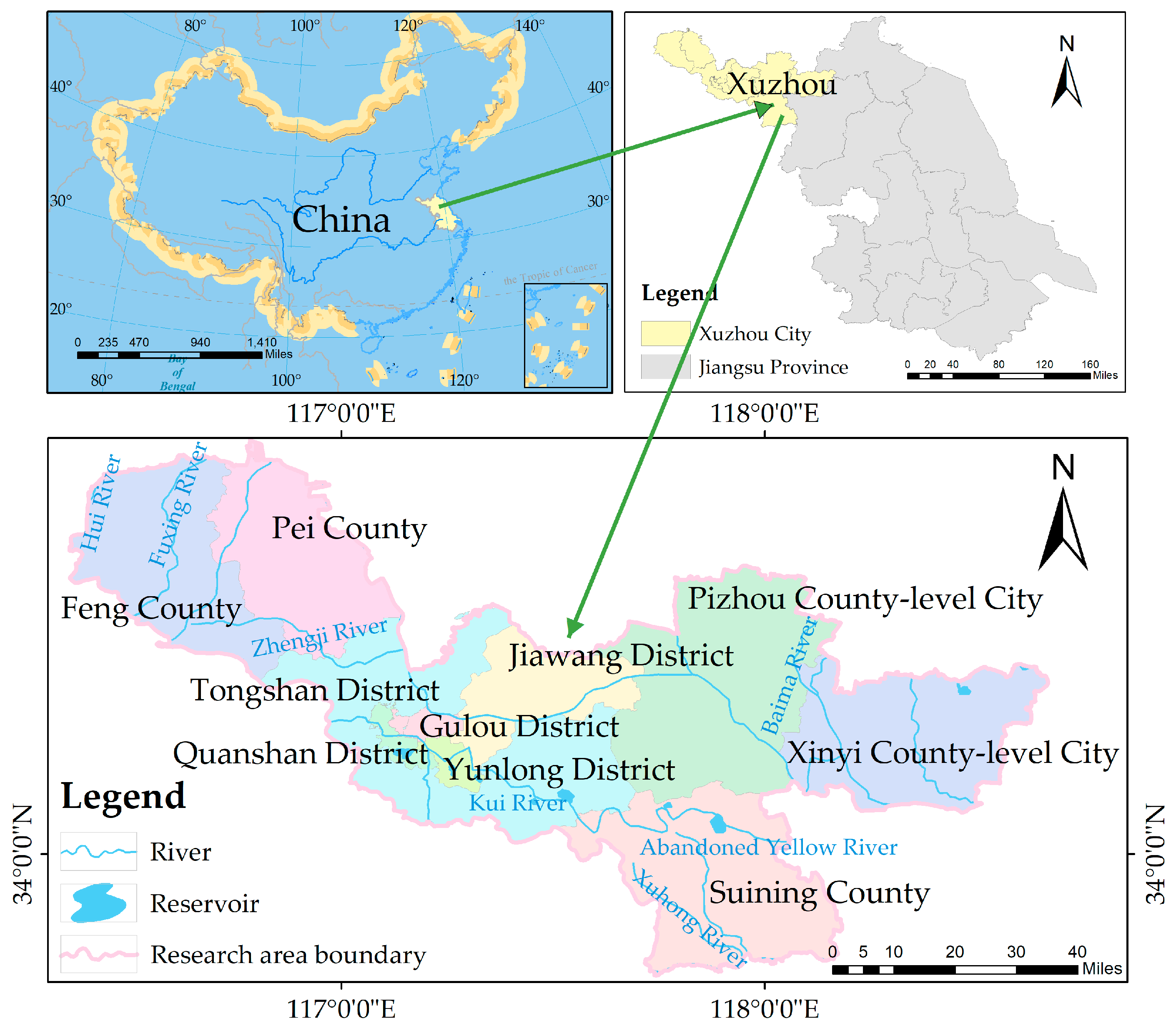
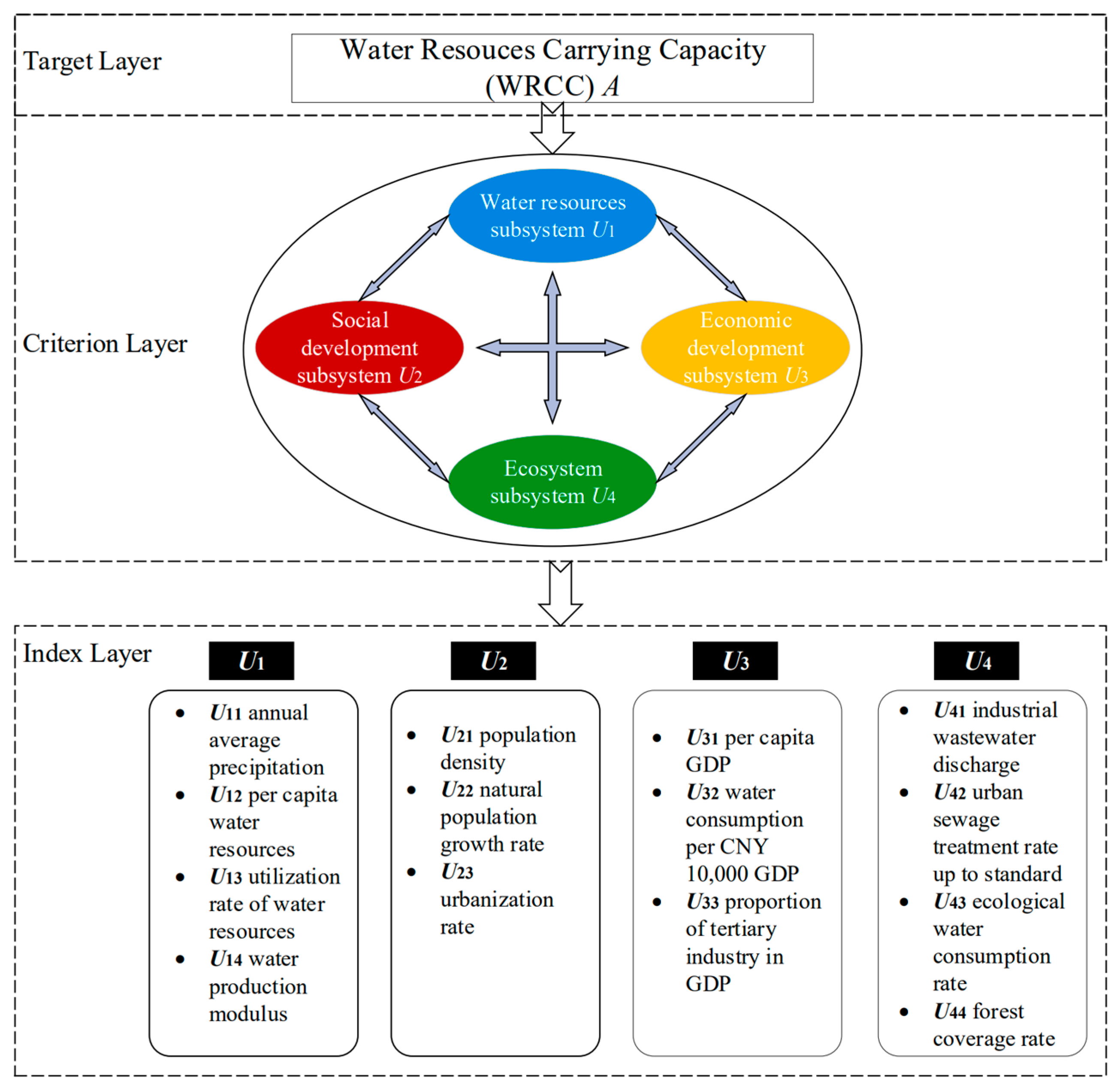
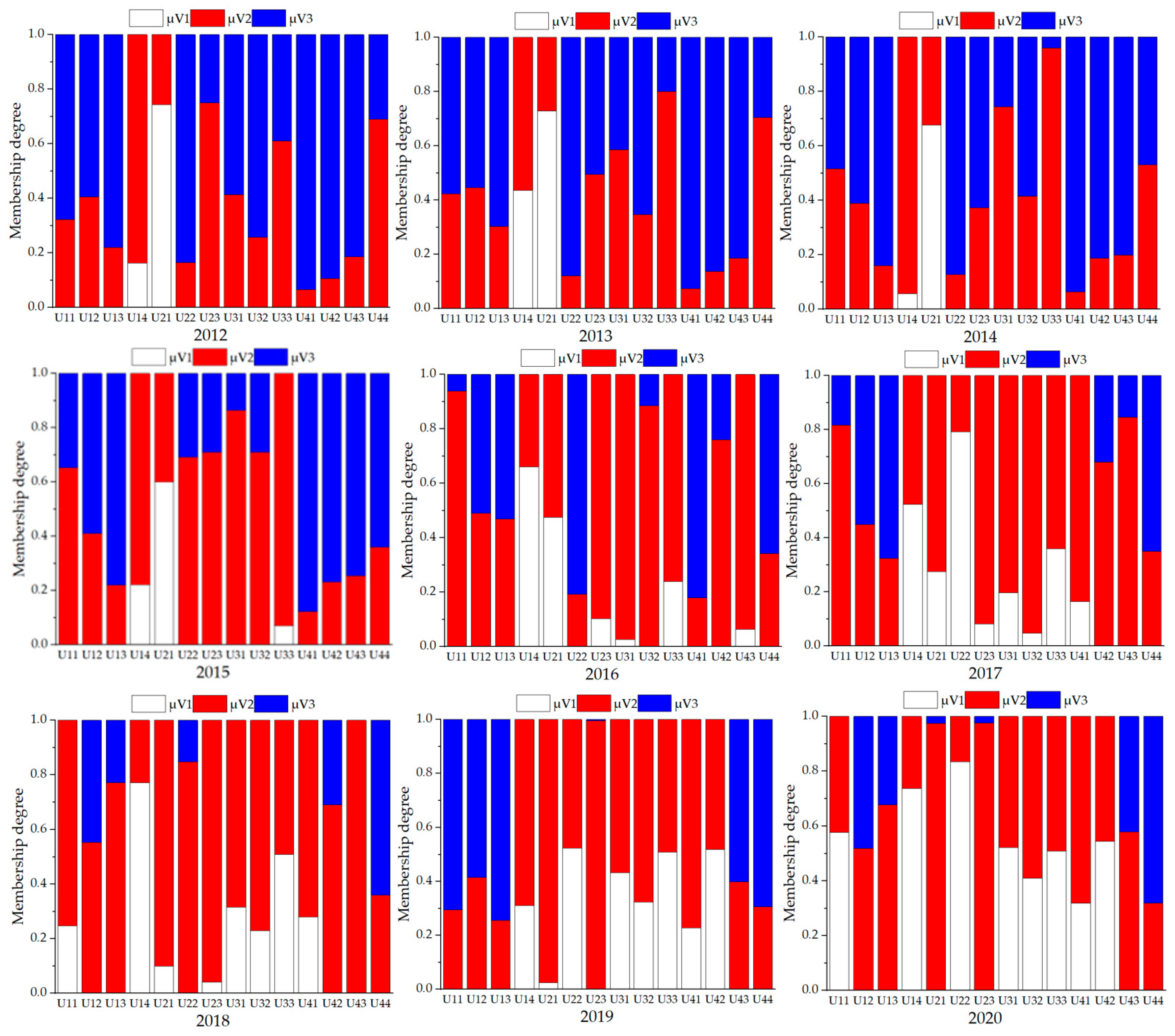

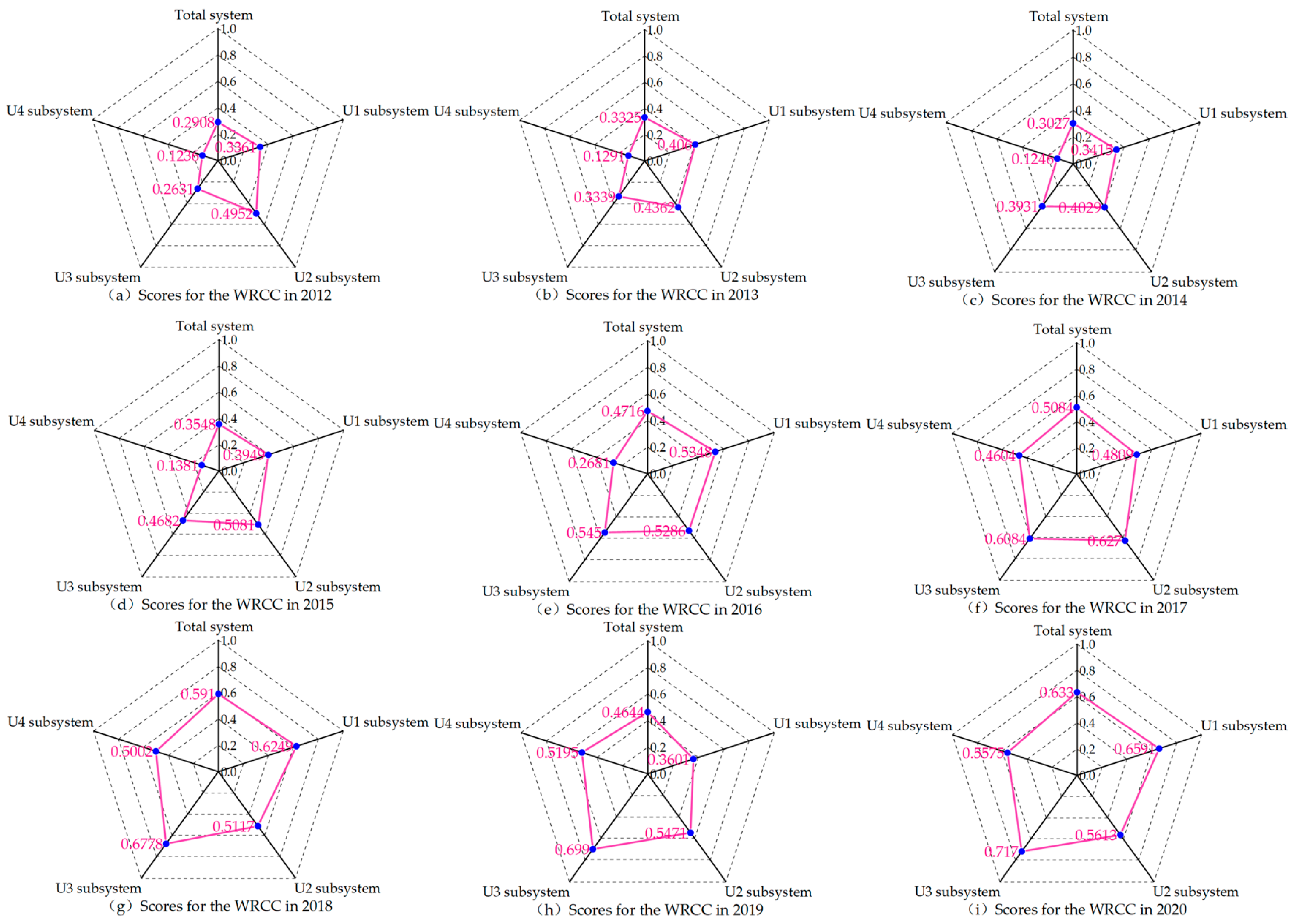
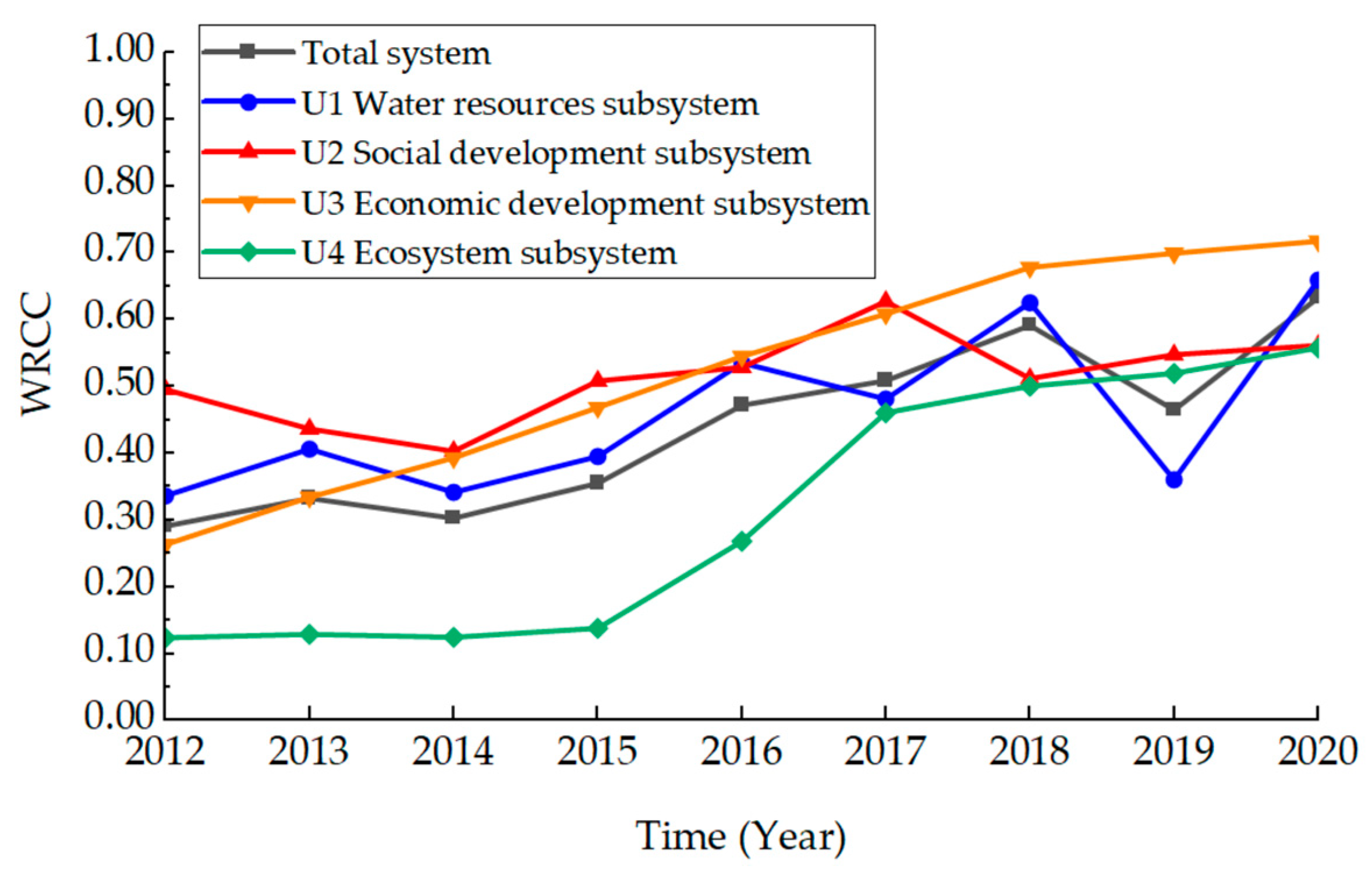
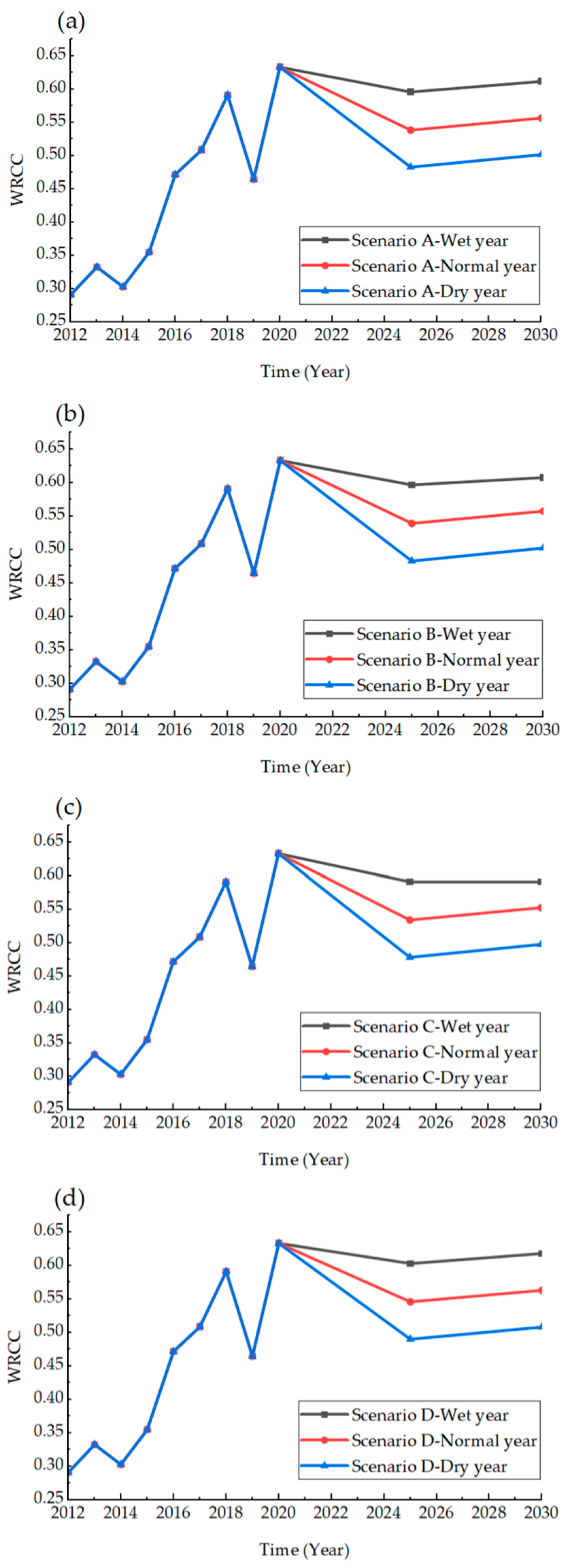
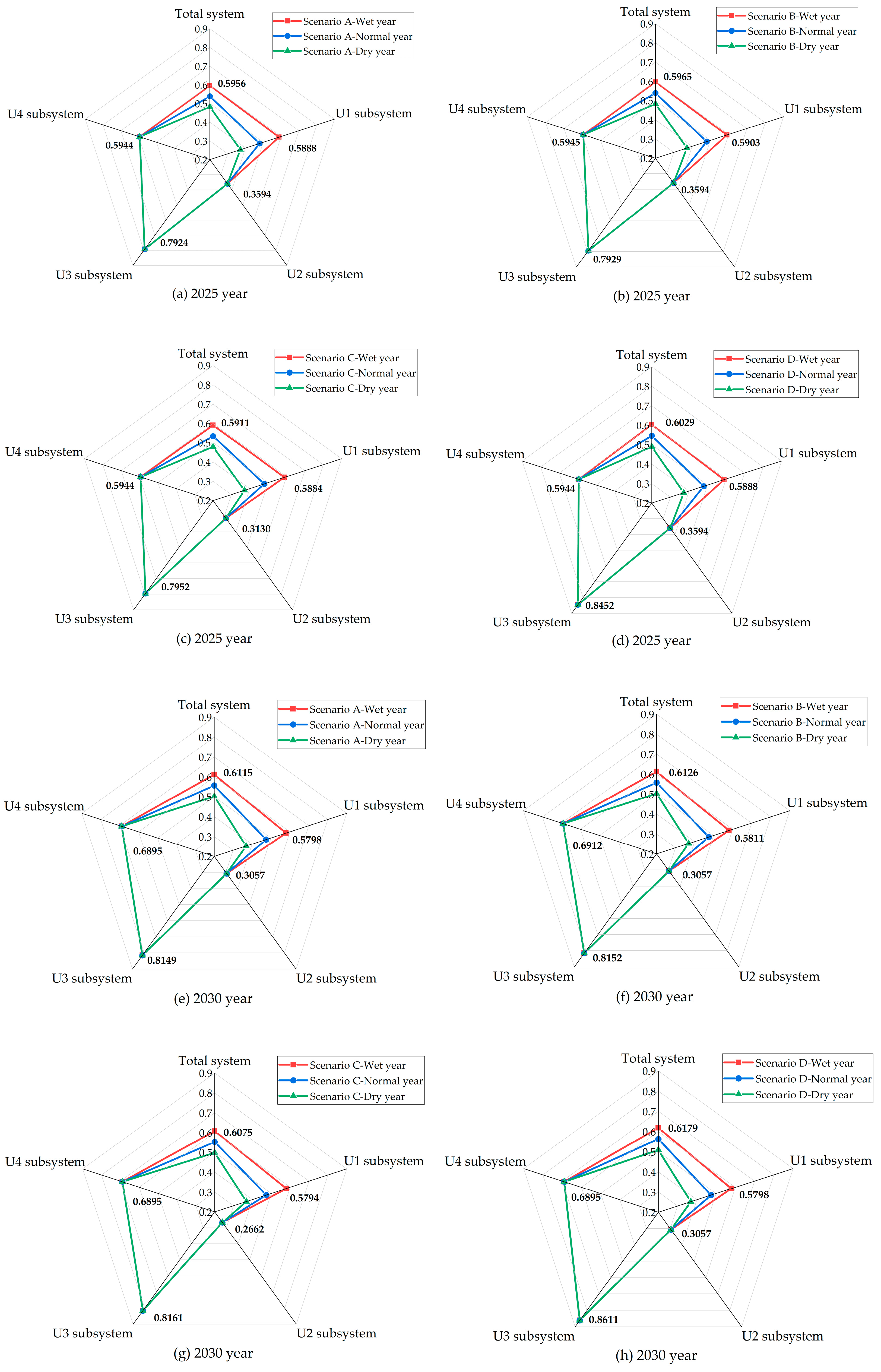
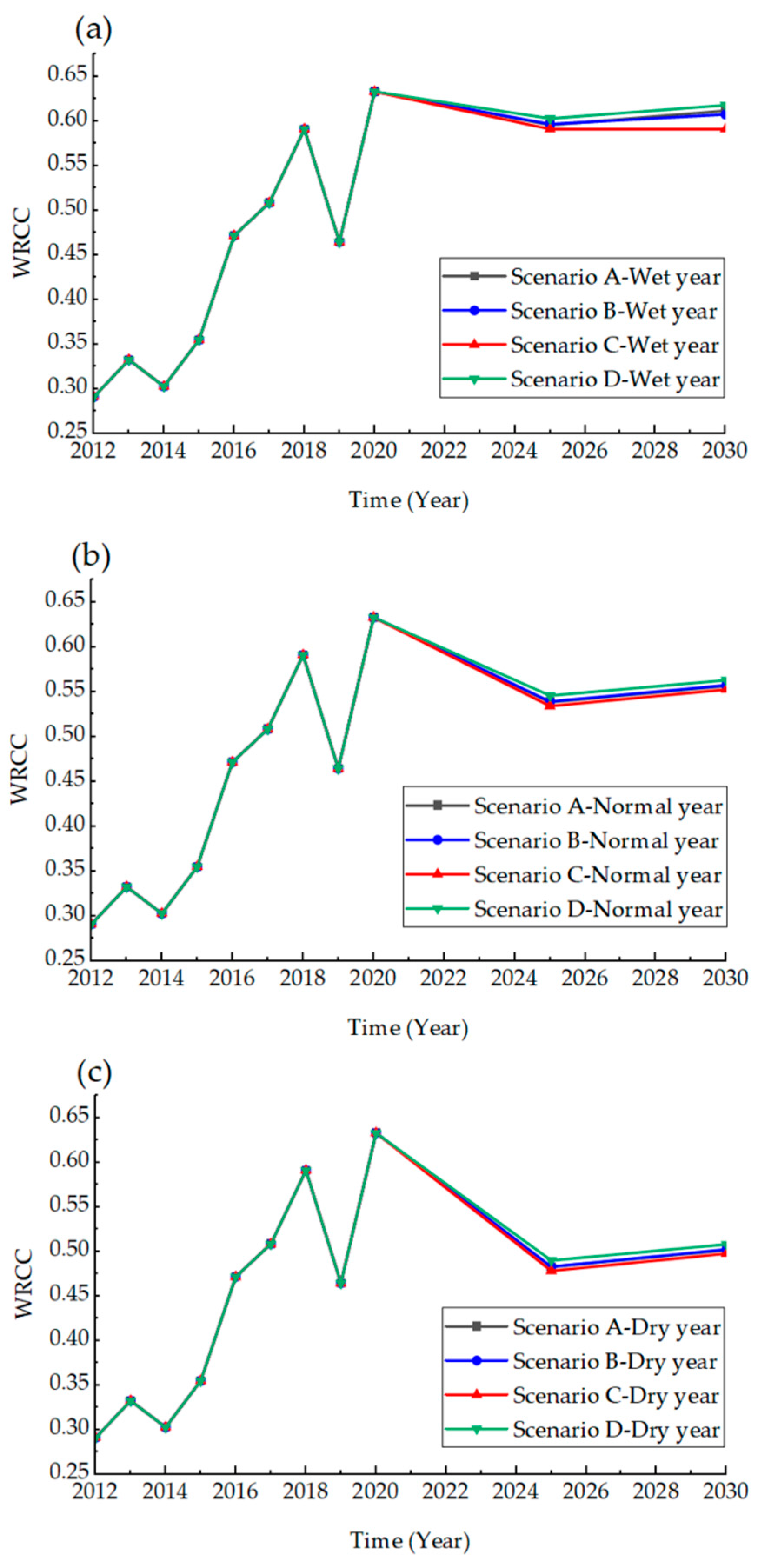
| Evaluation Indexes | Unit | Index Type | V1 (Strong) | V2 (Average) | V3 (Weak) |
|---|---|---|---|---|---|
| U11 (annual average precipitation) | mm | positive | >1000 | 750–1000 | <750 |
| U12 (per capita water resources) | m3/people | positive | >1700 | 500–1700 | <500 |
| U13 (utilization rate of water resources) | % | negative | <40 | 40–90 | >90 |
| U14 (water production modulus) | 104 m3/km2 | positive | >34 | 15–34 | <15 |
| U21 (population density) | person/km2 | negative | <750 | 750–790 | >790 |
| U22 (natural population growth rate) | ‰ | negative | <5 | 5–10 | >10 |
| U23 (urbanization rate) | % | negative | <60 | 60–80 | >80 |
| U31 (per capita GDP) | CNY 10,000 | positive | >8 | 5–8 | <5 |
| U32 (water consumption per CNY 10,000 GDP) | m3/CNY 10,000 | negative | <50 | 50–80 | >80 |
| U33 (proportion of tertiary industry in GDP) | % | positive | >50 | 40–50 | <40 |
| U41 (industrial wastewater discharge) | 104 tons | negative | <2000 | 2000–5000 | >5000 |
| U42 (urban sewage treatment rate up to standard) | % | positive | >95 | 85–95 | <85 |
| U43 (ecological water consumption rate) | % | positive | >10 | 5–10 | <5 |
| U44 (forest coverage rate) | % | positive | >40 | 30–40 | <30 |
| Relative Importance | Definition |
|---|---|
| 1 | Equal significance between the two factors |
| 3 | Slight significance of one factor compared to the other |
| 5 | Strong significance of one factor compared to the other |
| 7 | Dominance of one factor over the other |
| 9 | Absolute dominance of one factor over the other |
| 2,4,6,8 | Intermediate state between the above two judgments |
| Reciprocal | If the ratio of the significance of factors i and j is aij, then the ratio of the significance of factors j and i is aji = 1/aij |
| n | 1 | 2 | 3 | 4 | 5 | 6 | 7 | 8 | 9 | 10 |
| RI | 0 | 0 | 0.58 | 0.90 | 1.12 | 1.24 | 1.32 | 1.41 | 1.45 | 1.49 |
| Comprehensive Score | Grading Standards of the WRCC |
|---|---|
| (0,0.25) | I—Severe overloading |
| [0.25,0.50) | II—Medium overloading |
| [0.50,0.60) | III—Critical overloading |
| [0.60,0.70) | IV—Weak loadable |
| [0.70,0.80) | V—Good loadable |
| [0.80,1) | VI—Ideal loadable |
| Scenarios Design | Mode | Details |
|---|---|---|
| Scenario A | sustainable development mode | Taking the 14th Five-Year Plan of Xuzhou City as a reference, the corresponding method is selected for each index value to predict. Use the values of the predicted indexes as a reference for other scenarios. |
| Scenario B | water conservation mode | The per capita water consumption quota in both urban and rural areas was reduced by 10% to obtain the relevant index values, while the other index values remain the same as predicted by the sustainable development scenario. |
| Scenario C | rapid socioeconomic development mode | The index values related to the economy, population and urbanization rate will be raised by 5%, 2% and 3%, respectively, and other index values will be the same as those in the sustainable development scenario. |
| Scenario D | adjustment of industrial structure mode | The proportion of tertiary industry in GDP is increased by 5% based on sustainable development, while the other indexes values remain the same as predicted by the sustainable development scenario. |
Disclaimer/Publisher’s Note: The statements, opinions and data contained in all publications are solely those of the individual author(s) and contributor(s) and not of MDPI and/or the editor(s). MDPI and/or the editor(s) disclaim responsibility for any injury to people or property resulting from any ideas, methods, instructions or products referred to in the content. |
© 2023 by the authors. Licensee MDPI, Basel, Switzerland. This article is an open access article distributed under the terms and conditions of the Creative Commons Attribution (CC BY) license (https://creativecommons.org/licenses/by/4.0/).
Share and Cite
Zhang, Y.; Song, X.; Wang, X.; Jin, Z.; Chen, F. Multi-Level Fuzzy Comprehensive Evaluation for Water Resources Carrying Capacity in Xuzhou City, China. Sustainability 2023, 15, 11369. https://doi.org/10.3390/su151411369
Zhang Y, Song X, Wang X, Jin Z, Chen F. Multi-Level Fuzzy Comprehensive Evaluation for Water Resources Carrying Capacity in Xuzhou City, China. Sustainability. 2023; 15(14):11369. https://doi.org/10.3390/su151411369
Chicago/Turabian StyleZhang, Ying, Xiaomeng Song, Xiaojun Wang, Zhifeng Jin, and Feng Chen. 2023. "Multi-Level Fuzzy Comprehensive Evaluation for Water Resources Carrying Capacity in Xuzhou City, China" Sustainability 15, no. 14: 11369. https://doi.org/10.3390/su151411369
APA StyleZhang, Y., Song, X., Wang, X., Jin, Z., & Chen, F. (2023). Multi-Level Fuzzy Comprehensive Evaluation for Water Resources Carrying Capacity in Xuzhou City, China. Sustainability, 15(14), 11369. https://doi.org/10.3390/su151411369










